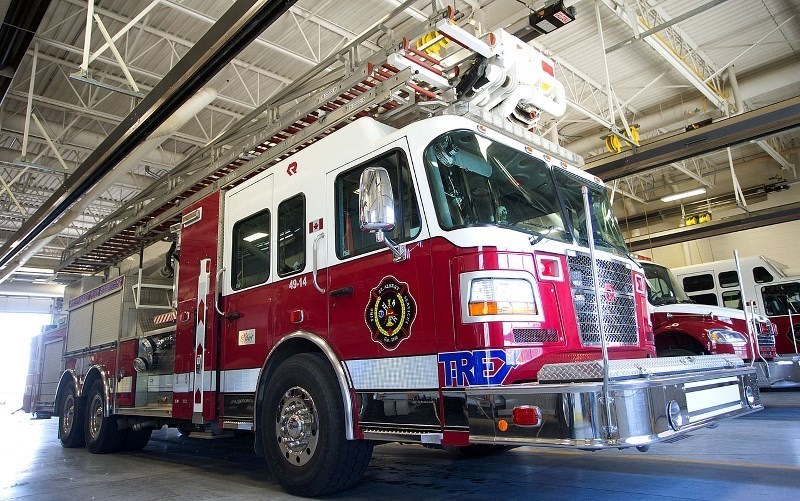It can take years to build a fire truck but only hours for them to be snatched up, which is why St. Albert city council has approved an extra $1 million to purchase a new aerial apparatus.
Everett Cooke, St. Albert Fire Services chief, was before council to seek approval for an increase to the amount they’re willing to spend on a new aerial apparatus, sometimes referred to as a “tower,” used to fight fires in tall buildings.
With a unanimous vote they gave him the extra $1 million, hiking the budget from $2.496 million to $3.496 million “so that a purchase can be made in a timely manner when apparatus becomes available,” but not without question.
Fire trucks that take 50 months to make, or which are snapped up off the shelf in less than two hours: This is what departments across the country and beyond are grappling with as they try to keep their fleets current.
“This is a must-have,” Coun. Ken MacKay said.
In 2019, new fire truck builds with custom specifications were expected to arrive about 24 months after they were ordered, Cooke said. Post-pandemic, that number is 50, even 52.
That means you could order a new engine with the features your department needs, train for and compete in two distinct Olympic games of the same season and receive that shiny red beauty in person.
You could take Royal Caribbean’s 274-day Ultimate World Cruise, see all seven continents and eight world wonders five times and not miss the delivery.
This is what fire departments are up against timewise. Many, St. Albert’s included, have shifted their focus to unmodified “stock” units, and demonstration (showroom) vehicles without all the “bells and whistles” that become available more often and are snapped up just as quickly.
“After getting information from one of many vendors (the department deals with), over the course of the last three months, once apparatus land on market, they last 2.5 to four hours,” Cooke said.
He later added that when a stock truck is bought, there is still an opportunity to add modifications. The new budget of $3.496 million allows for the base price of the truck, expected to come in at $2.8 million, plus any of those custom additions.
“It’s not our intent to use that entire amount, but it gives us that buffer should future apparatus, in Q4 of 2024, increase another two per cent,” he said, answering a question from Coun. Shelley Biermanski.
Funding for a new tower truck was approved in 2022, but the buying process was held up by vacancies in leadership positions at the department. Cooke said there was a period where the only administrators on staff were himself and a retired member on contract. When the vacancies were filled, portfolios shifted around.
“These are the folks who would be leading procurement activities working with our procurement department and of course our apparatus committee of members,” Cooke said.
Built into the approved amount for the fire truck was a two-per-cent annual increase in order to keep pace with inflation as has been the city’s practice. Diane McMordie, CFO and managing director of Corporate and Emergency Services, noted that in the last two to three years, they’re having to mark things up closer to eight per cent annually when replacing existing vehicles.
Cooke called it a new “industry norm.”
The new tower truck is to live at the yet-to-be-built Fire Hall #4 at St. Albert Trail and Neil Ross Road. Cooke said when the hall was approved in 2019, vendors were increasing the prices of their stock annually. Now, they’re updating window stickers quarterly.
Mayor Cathy Heron used the example to make a point.
“It really highlights when council decides to delay a capital project just to save money that year, it costs residents more in the long run,” she said. “It’s interesting.”
Cooke said off the top of his head, he could recall five fire truck vendors active in the market St. Albert competes in. The last unit St. Albert purchased from Maxi-Metal in Quebec, which has been building “intervention vehicles” since 1983, just entered Ontario on its way here.
A “blindsided” Coun. Sheena Hughes drilled down on the delay, pushing back on the idea that council was responsible for holding the purchase up. She asked why the city decided to “sit on” for seven months the decision to going after stock trucks, a characterization CAO Bill Fletcher, disagreed with.
“It takes time for the committee to come up with specifications, the estimate had to be revisited when it was determined that those specifications would result in a 52-month return,” he said. “The moving date of Fire Hall #4 did have an effect: You need to store these vehicles somewhere other than outside. There was a delay … but from the discussions last year until now I don’t believe is unreasonable.”
Two fire trucks are up for replacement with the option for a third, which would be seen as a “growth unit” to the fleet. The first unit is expected to arrive in 12 months, the second about six to eight months after that, and the third if the city takes the option to buy, at the end of 2026.
The city’s rescue unit is also coming up for replacement and would be the focus of the fire department’s procurement activities next.
Cooke told Hughes he is “very confident, provided the right apparatus drops,” the city could acquire a new aerial truck sooner.
The chief said the department plans to have a consultant review staff levels, equipment and response times throughout the city with the intent of providing a report to council next year.




